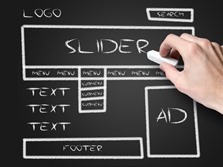Your business’s website is a combination of a million tiny things that all come together to sell your products, entertain your customers, and support your brand. Every decision you make, from the photos you use to the size of the font contributes to the overall effectiveness and feeling of your site — and the wrong choices can send the wrong message about your brand.
The good news is that when you make your own website, you can solidify your brand right from the start by keeping a few key principles in mind and putting them to work as you make your selections. Even if you’re new to web design, if you remember these points, you’ll develop an attractive, functional site that gets results right from the start.
1. Use Color Correctly
Branding with color isn’t about choosing colors that are pretty or that you personally prefer. It’s not even totally about aesthetics, either. Color is packed with meaning, and can have a profound effect on how your customers view and respond to your site. For example, the color red is often associated with power and energy, and can actually increase blood pressure and respiration, while shades of green and blue are more calming and associated with peace. As you select colors to use on your site and your marketing materials, pay close attention to the psychological and cultural aspects of each shade, and choose carefully.
2. Choose the Right Images
It’s a cliché, but it rings true: A picture is worth a thousand words. Don’t skimp on imagery on your website, selecting overused or irrelevant stock photos, or even worse, try to save money by taking your own photos and winding up with blurry, out of focus photos — or worse. When you use attractive, high-quality images on your site that feature your actual products, staff and location, you build trust because your audience can see exactly what they are getting, rather than a stock photo that feels generic and impersonal.
3. Repeat Elements
It might be fun to flex your creative muscles and give every page on your site a different layout, but the fact is, consistency is better. Repeating elements of your design allows you to create stylesheets in your content management system, which speeds up your site while also creating a consistent experience for the user. Instead of having to load every element of every page, a stylesheet caches elements so they load quickly, and a fast loading site is vital to a great user experience and positive perception of your brand.
4. Set the Tone
When writing content for your site, you need to set the tone for your brand — and remain consistent throughout the entire site. Remember, it’s not just what you say, but how you say it. Let the personality of your business come across in your tone. Don’t be afraid to be playful when appropriate, or be serious when necessary. The tone doesn’t only apply to the site text, either. The fonts and colors you choose can convey seriousness or whimsy, casual or formal, fresh and modern or more traditional, etc., so choose those elements to align with your brand and the purpose of your business.
5. Set Yourself Apart
You have worked hard to establish your brand, so why would you want your website to look just like your competitor’s? While you want to adhere to certain conventions, you want to make your site as unique as possible. This might mean using a pop of unexpected color, a more dynamic design, or multimedia elements or animation. Use your competitor’s sites for inspiration, but look for ways that you can set yourself apart and make your site feel more unique and reflective of your unique brand.
6. Don’t Forget Your Value Proposition
Finally, a key part of establishing your brand on your website is effectively communicating your value proposition. What do you bring to the table? How can customers benefit from working with you over your competitors? If all of your elements work together — the design, text, colors, fonts, images, etc. — they should support your value proposition and show exactly what customers stand to gain from your business. When that happens, they are more likely to buy, and your business will grow.
Developing an effective website that supports your brand is in some ways a process of trial and error. Through testing and refinement, though, you can determine the elements that work and which need to be fixed. However, if you start with an eye toward supporting your brand, you’ll find that you will be closer than you expect from the very start.


